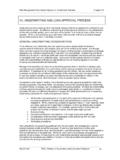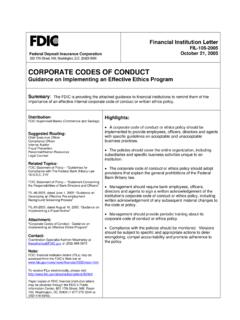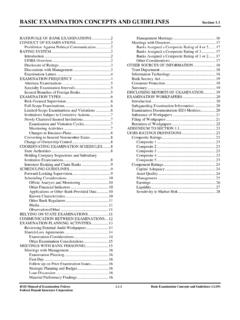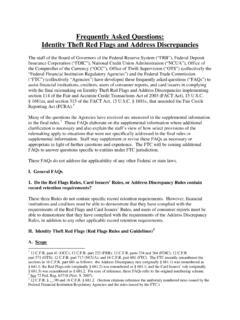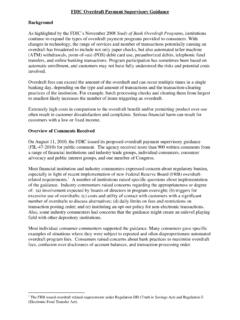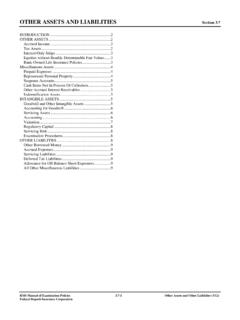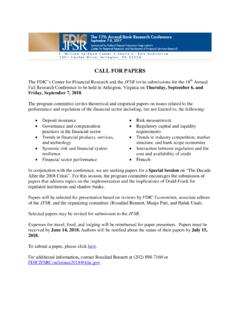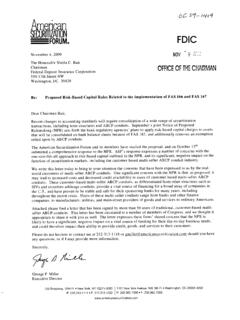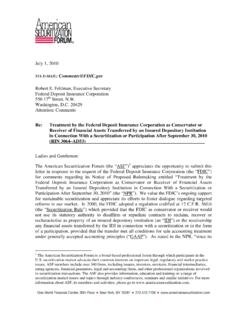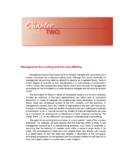Transcription of CAPITAL Section 2 - Federal Deposit Insurance Corporation
1 CAPITAL Section Risk management Manual of Examination Policies 2. 1-1 CAPITAL (4/ 15) Federal Deposit Insurance Corporation 2 Purpose of CAPITAL .. 2 REGULATORY CAPITAL REQUIREMENTS .. 2 Other Regulatory Requirements .. 3 COMPONENTS OF CAPITAL .. 3 Common Equity Tier 1 CAPITAL .. 3 Additional Tier 1 3 Tier 2 CAPITAL .. 3 Deductions and Limits .. 4 RISK-WEIGHTED ASSETS .. 4 Standardized Approach .. 4 High Volatility Commercial Real Estate Loans (HVCRE) .. 4 Structured Securities and Securitizations .. 5 Securitization Due Diligence .. 5 Equity Risk Weights .. 5 Collateralized Transactions .. 6 Treatment of Guarantees .. 6 Off-Balance Sheet Exposures .. 6 Advanced Approaches .. 6 MINIMUM REGULATORY CAPITAL RATIOS .. 7 Supplementary Leverage Ratio .. 7 CAPITAL Conservation Buffer .. 7 PROMPT CORRECTIVE ACTION .. 8 EXAMINATION-IDENTIFIED DEDUCTIONS FROM COMMON EQUITY CAPITAL .. 9 Identified Losses and Inadequate Reserves.
2 9 Other Real Estate Reserves .. 9 Liabilities Not Shown on Books .. 9 CAPITAL 10 CAPITAL Plans .. 10 Increasing CAPITAL in Operating Banks .. 11 Contingent Liabilities .. 11 Common Forms of Contingent Liabilities .. 12 EVALUATING CAPITAL ADEQUACY .. 14 Financial Condition of the Institution .. 14 Quality of CAPITAL .. 14 Emerging Needs for Additional CAPITAL .. 14 Problem Assets .. 14 Balance Sheet Composition .. 15 Off-Balance Sheet Risk Exposures .. 15 Earnings and Dividends .. 15 Asset Growth .. 15 Access to CAPITAL Sources .. 15 RATING THE CAPITAL FACTOR .. 15 Uniform Financial Institution Rating System .. 16 Ratings .. 16 CAPITAL Section CAPITAL (4/15) 2. 1-2 Risk management Manual of Examination Policies Federal Deposit Insurance Corporation INTRODUCTION Purpose of CAPITAL Bank CAPITAL performs several very important functions. It absorbs losses, promotes public confidence, helps restrict excessive asset growth, and provides protection to depositors and the Deposit Insurance funds.
3 Absorbs Losses CAPITAL allows institutions to continue operating as going concerns during periods when operating losses or other adverse financial results are experienced. Promotes Public Confidence CAPITAL provides a measure of assurance to the public that an institution will continue to provide financial services even when losses have been incurred, thereby helping to maintain confidence in the banking system and minimize liquidity concerns. Restricts Excessive Asset Growth CAPITAL , along with minimum CAPITAL ratio standards, restrains unjustified asset expansion by requiring that asset growth be funded by a commensurate amount of additional CAPITAL . Protects Depositors and the Deposit Insurance Fund Placing owners at significant risk of loss, should the institution fail, helps to minimize the potential for moral hazard, and promotes safe and sound banking practices.
4 The FDIC, as the primary insuring agency, has a responsibility to protect depositors and the Deposit Insurance fund. Consequently, the FDIC focuses attention on the adequacy of CAPITAL during bank examinations and in supervisory programs. For example, examiners carefully review asset and liability accounts to determine adjusted equity levels, as compared to simply identifying book CAPITAL . Similarly, examiners identify higher-risk assets, such as adversely classified loans, and assets listed for special mention or as concentrations, because the assets may contribute to losses or weaken CAPITAL in the future. Additionally, examiners review bank policies and procedures, and management s qualifications and performance, to identify weaknesses that could hinder earnings or reduce CAPITAL . And finally, to assess the potential effect on CAPITAL , examiners review bank s earnings, CAPITAL -distribution plans, and contingent liabilities that may arise from banking relationships, trust activities, or litigation.
5 REGULATORY CAPITAL REQUIREMENTS Regulatory CAPITAL requirements have evolved as innovations in financial instruments and investment activities introduced greater complexity to the banking industry. To ensure regulatory requirements keep pace with these changes, Federal banking agencies revised the rules governing qualifying CAPITAL instruments and minimum CAPITAL levels. CAPITAL rules in the generally follow a framework of rules adopted by the Basel Committee on Banking Supervision (BCBS), an international standard-setting body that deals with various aspects of bank supervision. The FDIC is a member of the BCBS and works with the Board of Governors of the Federal Reserve System (FRB) and the Office of the Comptroller of the Currency (OCC) to establish domestic CAPITAL regulations.
6 In 2013, the FDIC, FRB, and OCC issued regulations for insured depository institutions in the that align with Basel III CAPITAL standards (Basel III). The standards and regulations are designed to strengthen the quality and quantity of bank CAPITAL and promote a stronger financial industry that is more resilient to economic stress. Basel III CAPITAL standards emphasize common equity tier 1 CAPITAL as the predominant form of bank CAPITAL . Common equity tier 1 CAPITAL is widely recognized as the most loss-absorbing form of CAPITAL , as it is permanent and places shareholders funds at risk of loss in the event of insolvency. Moreover, Basel III strengthens minimum CAPITAL ratio requirements and risk-weighting definitions, increases Prompt Corrective Action (PCA) thresholds, establishes a CAPITAL conservation buffer, and provides a mechanism to mandate counter-cyclical CAPITAL buffers.
7 Basel III standards apply to all insured depository institutions. For FDIC-supervised institutions, the CAPITAL rules are contained in Part 324 of the FDIC Rules and Regulations. Part 324 defines CAPITAL elements, establishes risk-weighting guidelines for determining CAPITAL requirements under the standardized and advanced approaches, and sets PCA standards that prescribe supervisory action for institutions that are not adequately capitalized. Part 324 also establishes requirements to maintain a CAPITAL conservation buffer that affects CAPITAL distributions and discretionary payments. The phase-in of Part 324 began on January 1, 2014 for advanced approach institutions1 and January 1, 2015 for community banks and 1 Generally, an advanced approaches institution is an institution that has consolidated total assets of $250 billion or more or has on-balance sheet foreign exposure of $10 billion or more.
8 Refer to Section CAPITAL Section Risk management Manual of Examination Policies 2. 1-3 CAPITAL (4/ 15) Federal Deposit Insurance Corporation other non-advanced approaches institutions. Full implementation of the rules for all institutions begins on January 1, 2019. This chapter provides an overview of the rule; however examiners should refer to Part 324 for specific rule text. Other Regulatory Requirements Examiners should be aware of other regulatory requirements that address CAPITAL requirements, such as: Topic Rule Risk-Based Insurance Premiums Part 327 of the FDIC Rules and Regulations Brokered deposits Section of the FDIC Rules and Regulations Limits on Extensions of Credit to Insiders Section of the FDIC Rules and Regulations and FRB Regulation O Activities and Investments Insured State Nonmember Part 362 of the FDIC Rules and Regulations Limitations on Interbank Liabilities Part 206 of FRB Regulations Limitations on Federal Reserve Discount Window Advances Section 10B of the Federal Reserve Act Grounds for Appointing of Conservator or Receiver Section 11(c)(5) of the Federal Deposit Insurance Act (FDI Act) COMPONENTS OF CAPITAL Part 324 establishes three components of regulatory CAPITAL .
9 Common equity tier 1 CAPITAL , additional tier 1 CAPITAL , and tier 2 CAPITAL . Tier 1 CAPITAL is the sum of common equity tier 1 CAPITAL and additional tier 1 CAPITAL . Total CAPITAL is the sum of tier 1 and tier 2 CAPITAL . Common equity tier 1 CAPITAL , tier 1 CAPITAL , and total CAPITAL serve as the numerators for calculating regulatory CAPITAL ratios. An institution s risk-weighted assets, as defined by Part 324, serve as the denominator for these ratios. Average total assets with certain adjustments serve as the denominator for the tier 1 leverage CAPITAL ratio. Common Equity Tier 1 CAPITAL Common equity tier 1 CAPITAL is the most loss-absorbing form of CAPITAL . It includes qualifying common stock and related surplus net of treasury stock; retained earnings; certain accumulated other comprehensive income (AOCI) elements if the institution does not make an AOCI opt-out election (refer to opt-out election discussion in next paragraph), plus or minus regulatory deductions or adjustments as appropriate; and qualifying common equity tier 1 minority interests.
10 It is important to note that the Federal banking agencies expect the majority of common equity tier 1 CAPITAL to be in the form of common voting shares. Part 324 allows all non-advanced approach institutions to make a permanent, one-time opt-out election, enabling them to calculate regulatory CAPITAL without AOCI. Such an election neutralizes the impact of unrealized gains or losses on available-for-sale bond portfolios in the context of regulatory CAPITAL levels. To opt-out, institutions must make a one-time permanent election on the March 31, 2015 Call Report. For institutions that do not or cannot opt-out, the AOCI adjustment to common equity tier 1 CAPITAL could have a significant impact on regulatory CAPITAL ratios if significant bond portfolio appreciation or depreciation occurs.
